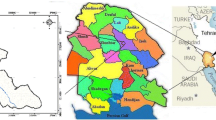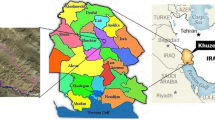Abstract
In flood management, analysis and modelling are needed, especially for the analysis of the occurrence of floods and decision making. One method for analyzing flood events can use the HEC–HMS software. In HEC–HMS, there are three sub-models, namely, losses, transform, and baseflow. In the development of the use of the HEC–HMS model, it still utilizes sub-model transform, where the peak rate factor (PRF) value is constant at 484 in modelling. The value of PRF is very dependent on the slope of the land (basin slope), where the value of this parameter is very varied depending on the physical condition of the area under study. Because of the fact, where the value of PRF should be varied depends on the slope in modelling stage; while the reality is still constant, this research is done. The research result shows that the role of PRF makes the modelling carried out using HEC–HMS produce comparable results as indicated by the objective function values in two study areas. The following is the comparison of the objective function of the Selorejo watershed in the March 2007 flood event between constant PRF 484 with variations in the values of PRF, RMSE (0.63 m; 0.59 m), CORREL (0.977; 0.976), and DELTAPEAK (43.04%; 41.46%). Whereas in the PDA Cipasang watershed, Nash–Sutcliffe (0.818; 0.820), RMSE (66.20 m3/s; 65.91 m3/s), CORREL (0.916; 0.917), and DELTAPEAK (15.55%; 15.35%). To utilize the variation of PRF into the model, based on the results of this study, the sub-model used is SCS Curve Number for Losses, SCS Units Hydrograph for Transform, and Recession Constant for Baseflow. It can be concluded that by including the influence of variations in PRF values resulting not a better model but only a slight improvement which is insignificant and a more complete model.



















Similar content being viewed by others
References
Fang X, Prakash K, Cleveland T, Thompson D, Pradhan P (2005) Revisit of NRCS unit hydrograph procedures. ASCE Proceedings, Austin, Texas
Khaddor I, Achab M, Soumali MR, Alaoui AH (2017) Rainfall-runoff calibration for semi-arid ungauged basins based on the cumulative observed hyetograph and SCS storm model: application to the Boukhalef Watershed (Tangier, North Western Morocco). JMES 8(10):3795–3808
Legates DR, McCabe GJ Jr (1999) Evaluating the use of “Goodness-of-Fit” measures in hydrologic and hydroclimatic model validation. Water Resour Res 35(1):233–241
Munajad R, Suprayogi S (2015) Kajian Hujan-Aliran Menggunakan Model HEC-HMS di Sub Daerah Aliran Sungai Wuryantoro Wonogiri, Jawa Tengah
Paimin S, Pramono IB (2009) Teknik Mitigasi Banjir dan Tanah Longsor. In: Ginting AN (ed) Balikpapan: tropenbos international indonesia programme. Retrieved from www.tropenbos.org
Pawitan H (2014) Perubahan Penggunaan Lahan dan Pengaruhnya Terhadap Hidrologi Daerah Aliran Sungai. Laboratorium Hidrometeorologi FMIPA IPB, Bogor
Pratiwi DT (2011) Analisis Hidrograf Aliran Menggunakan HEC-HMS (Studi kasus: DAS Citarum Hulu)
Sheridan JM, Merkel WH, Bosch DD (2002) Peak rate factors for flatland watersheds. Appl Eng Agric 18:65–69
Sitanggang GE, Suprayogi I, Trimaijon (2014) Pemodelan Hujan Debit Pada Sub Daerah Aliran Sungai Menggunakan Program Bantu HEC-HMS (Studi Kasus Pada Kanal Duri)
Wanielista M, Kersten R, Eaglin R (1997) Hydrology:water quantity and quality control (John Wiley & Sons Inc., New York). J Cent South Univ Technol 15(1):311–315. https://doi.org/10.1007/s11771-008-0370-7
Author information
Authors and Affiliations
Corresponding author
Additional information
Publisher's Note
Springer Nature remains neutral with regard to jurisdictional claims in published maps and institutional affiliations.
Electronic supplementary material
Below is the link to the electronic supplementary material.
Rights and permissions
About this article
Cite this article
Cahyono, C., Adidarma, W.K. Influence analysis of peak rate factor in the flood events’ calibration process using HEC–HMS. Model. Earth Syst. Environ. 5, 1705–1722 (2019). https://doi.org/10.1007/s40808-019-00625-8
Received:
Accepted:
Published:
Issue Date:
DOI: https://doi.org/10.1007/s40808-019-00625-8




